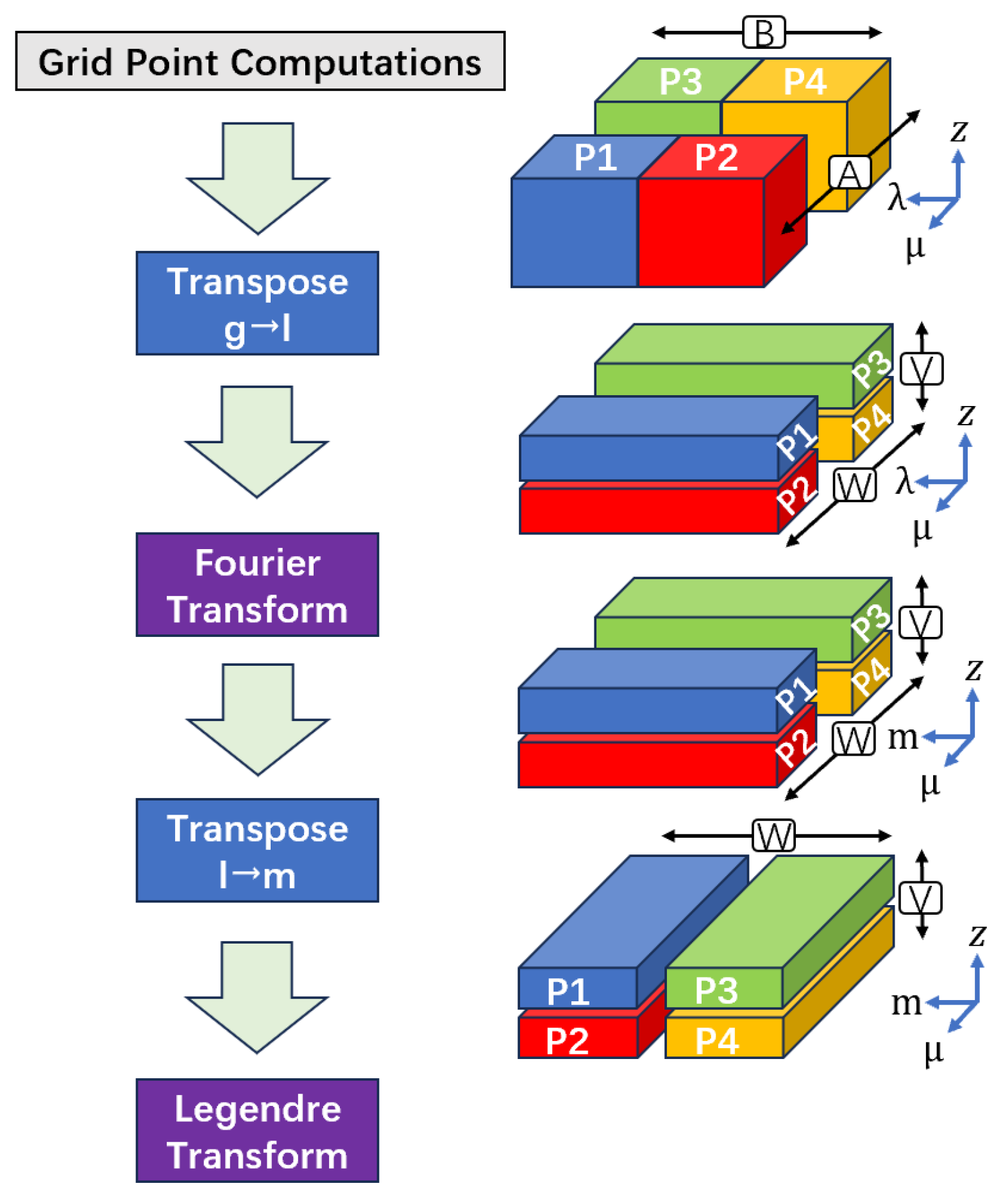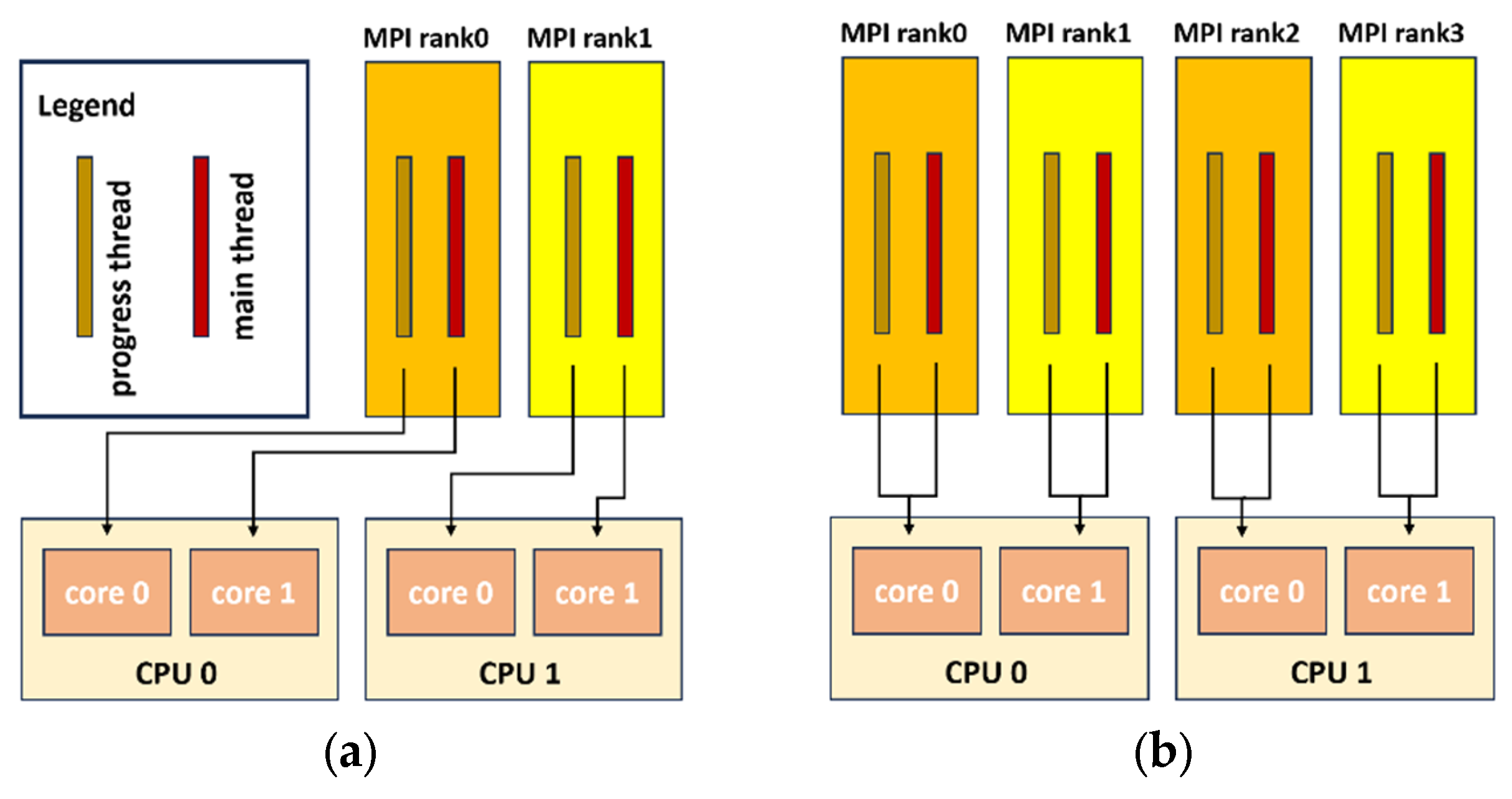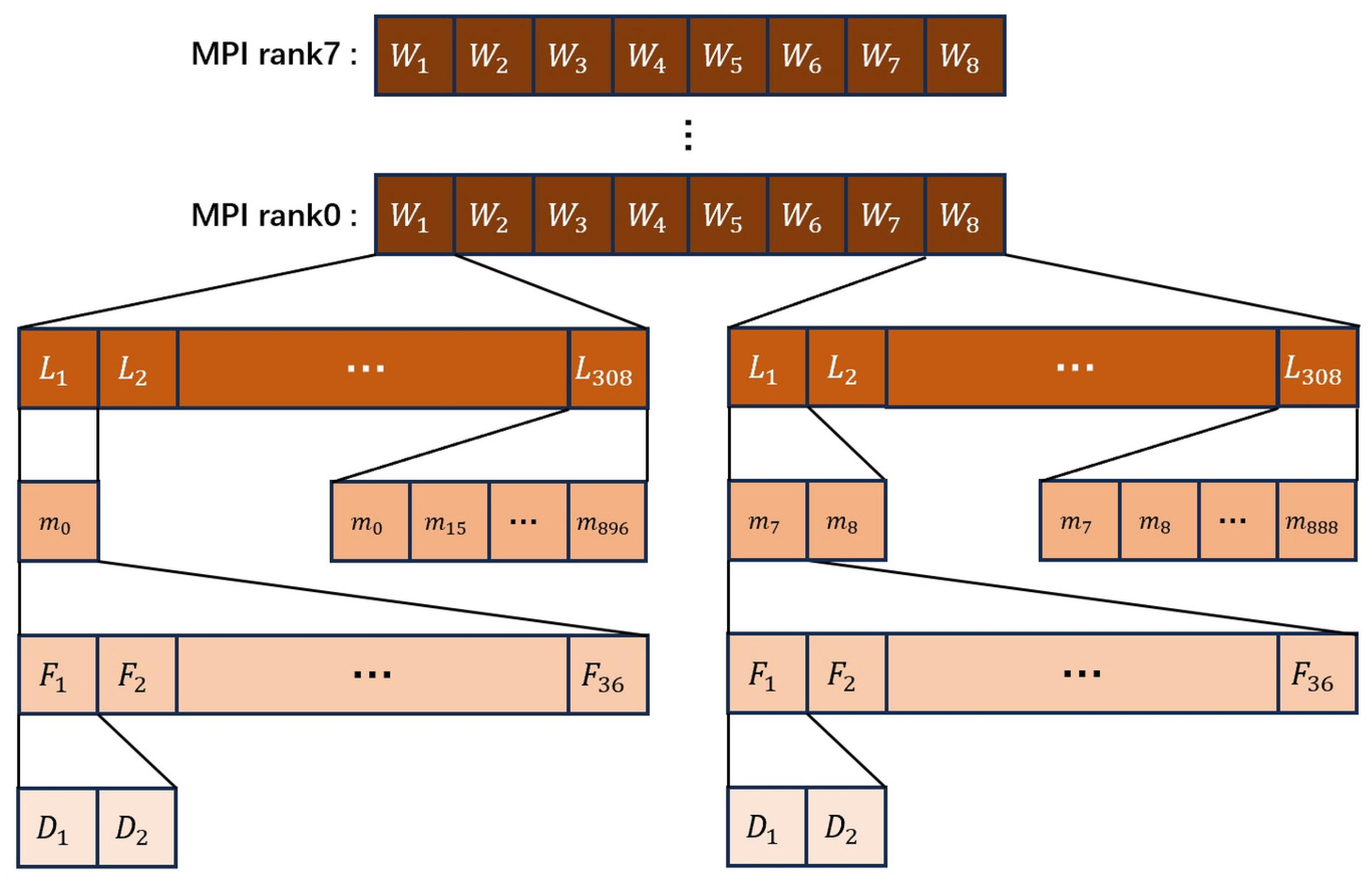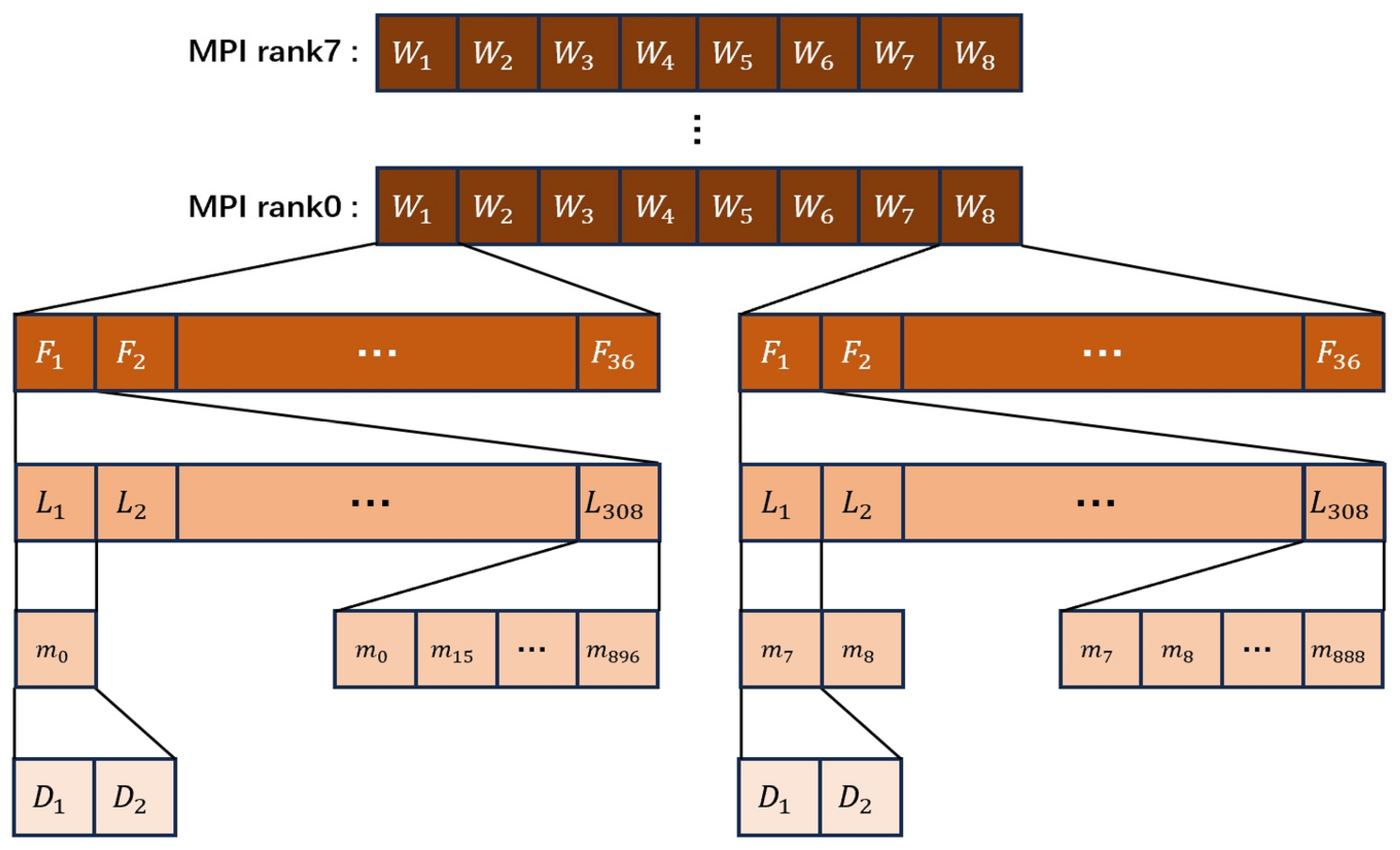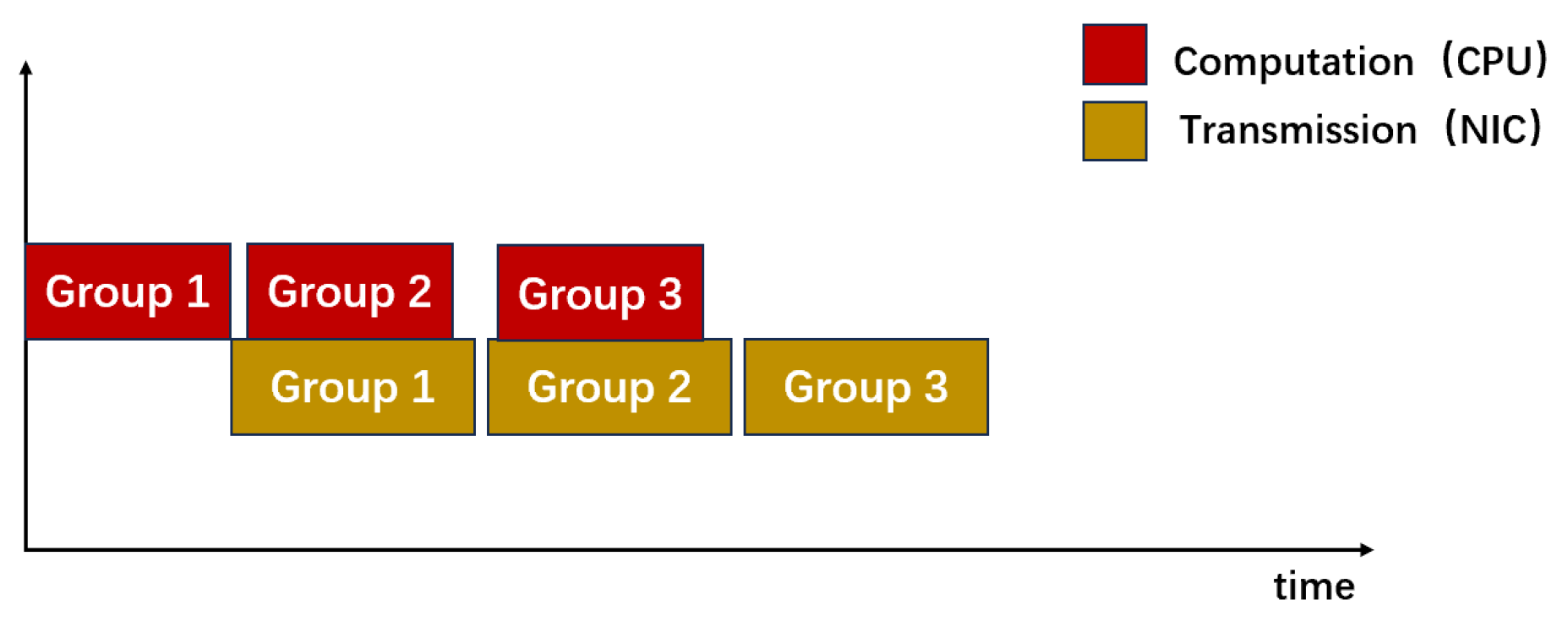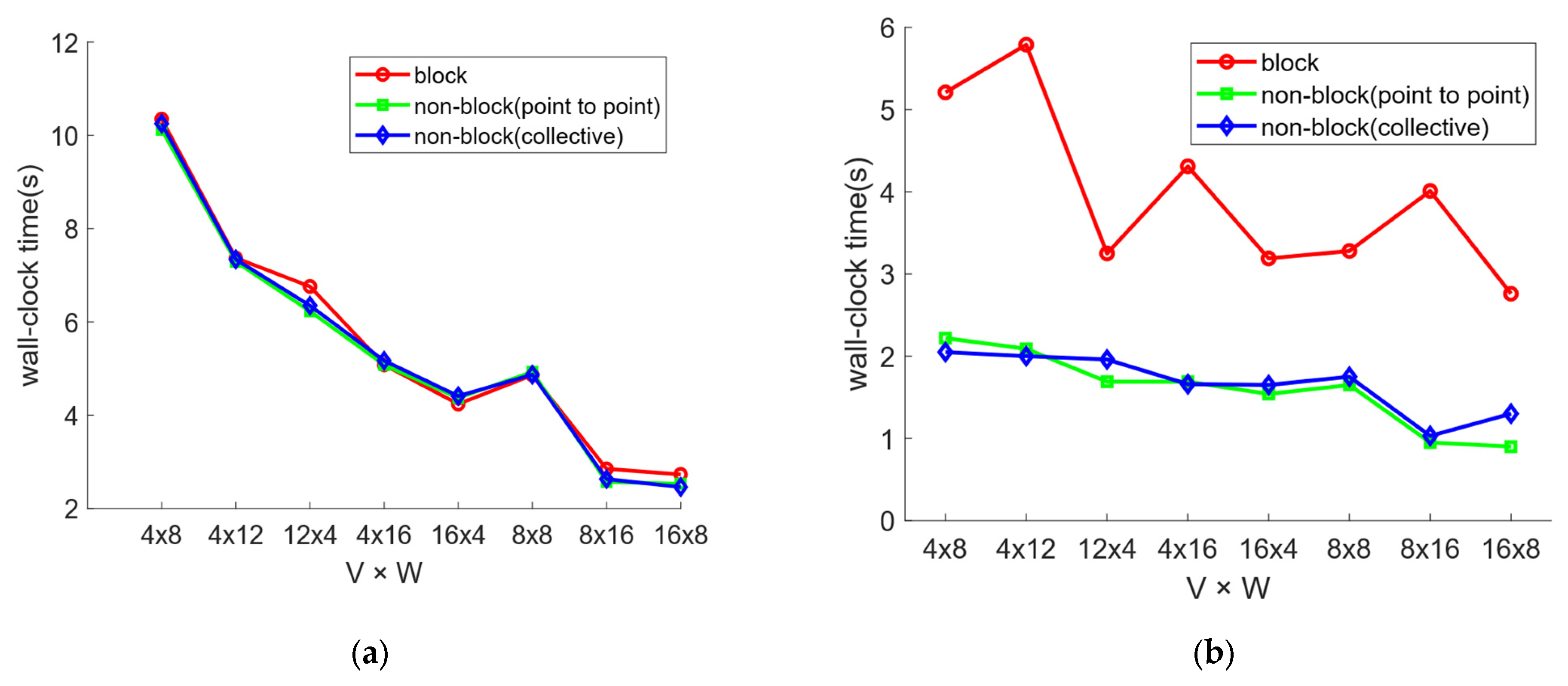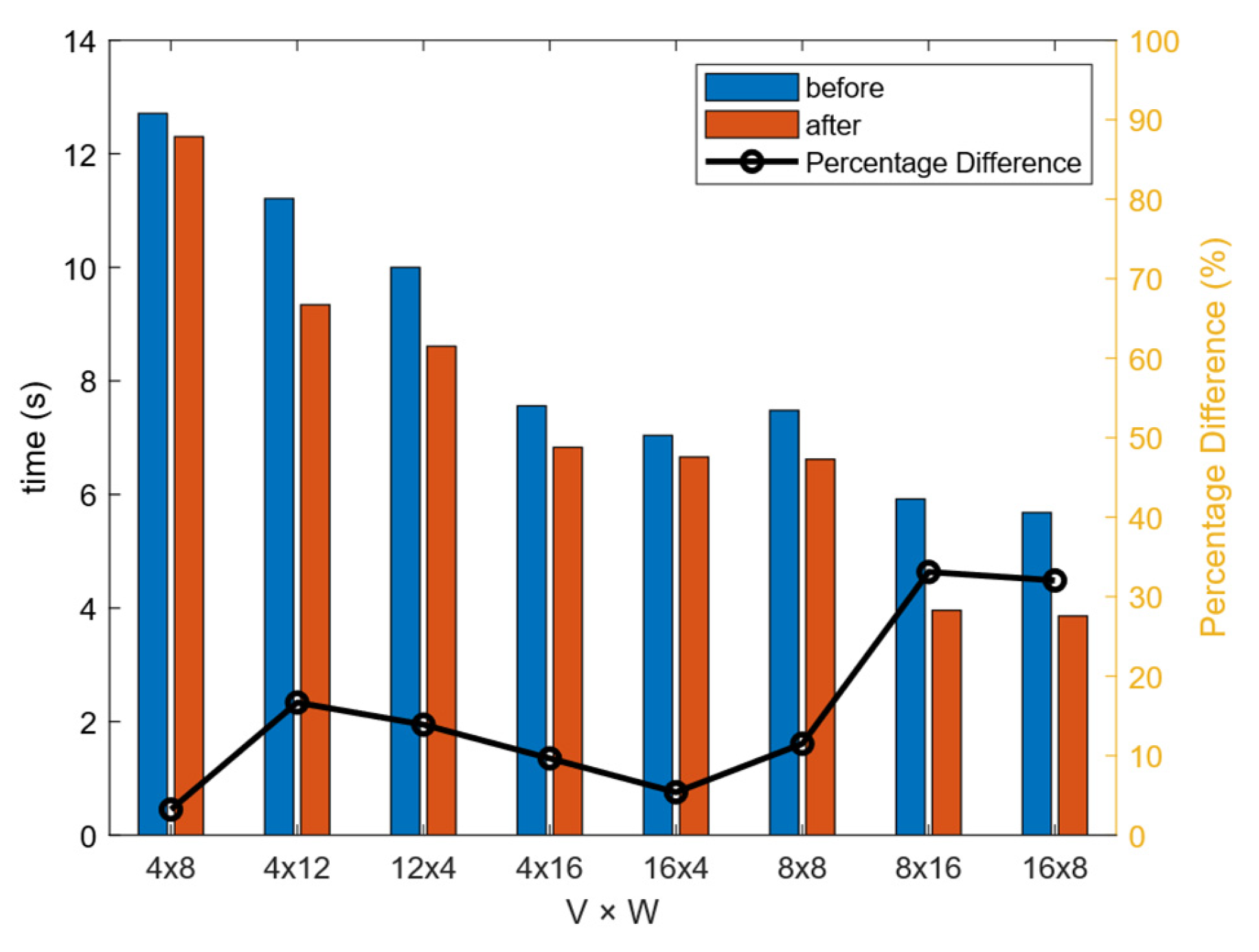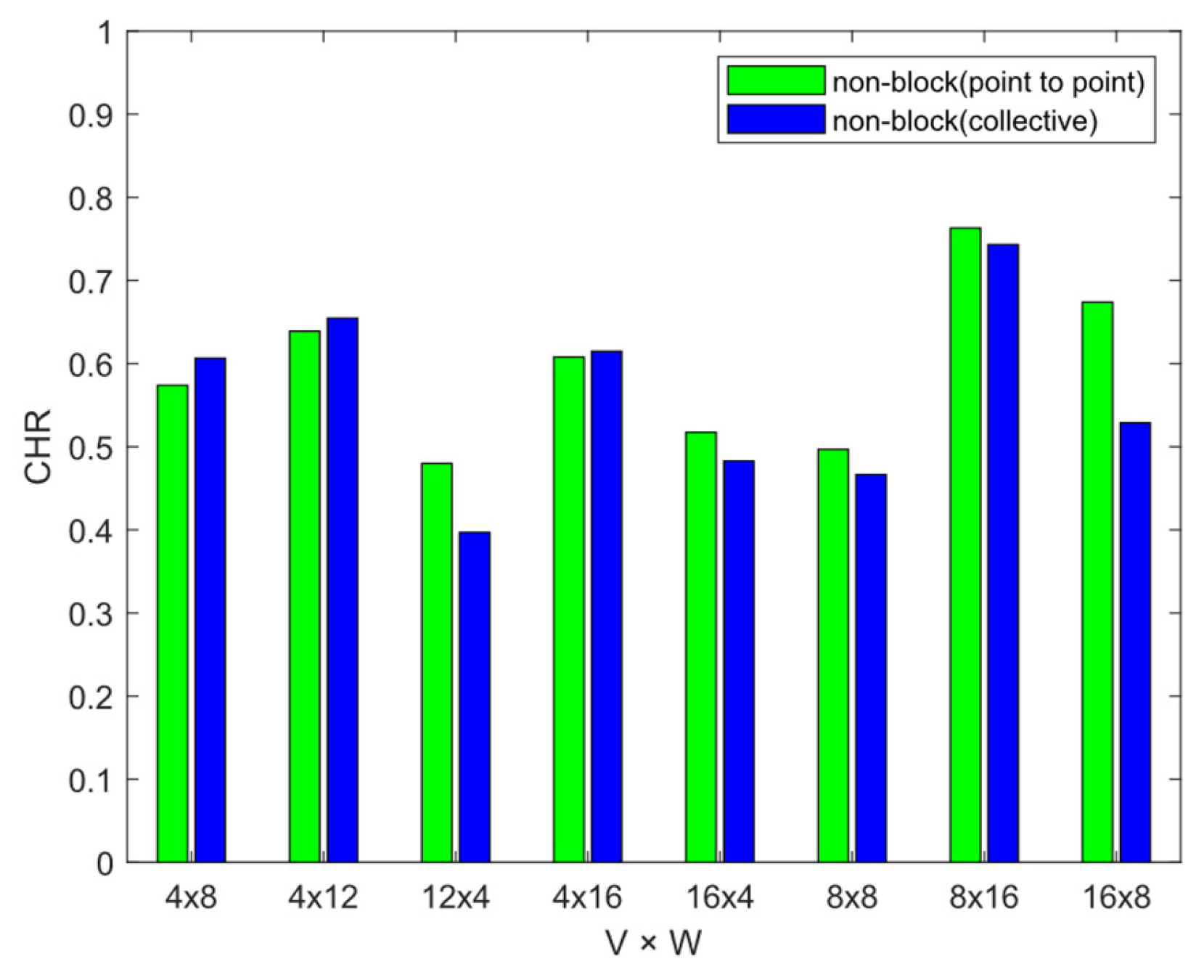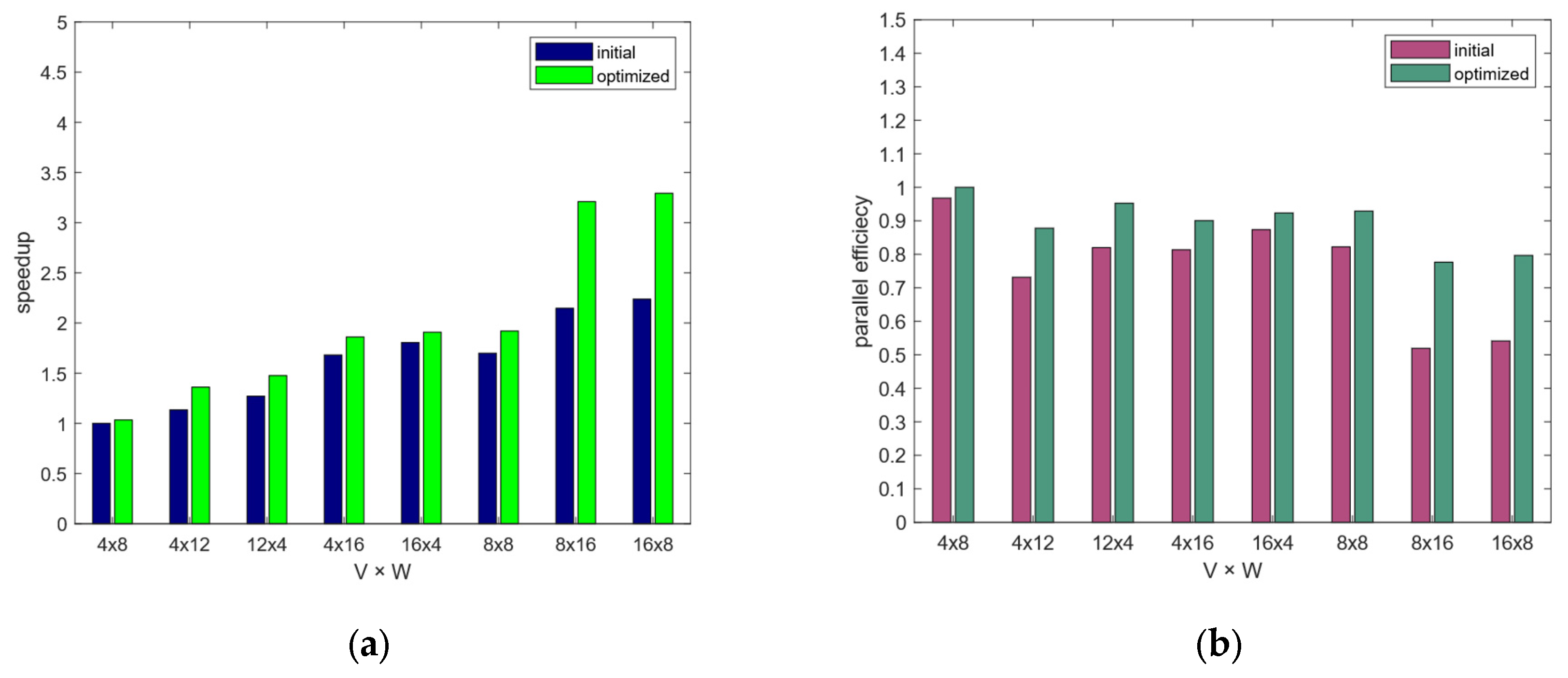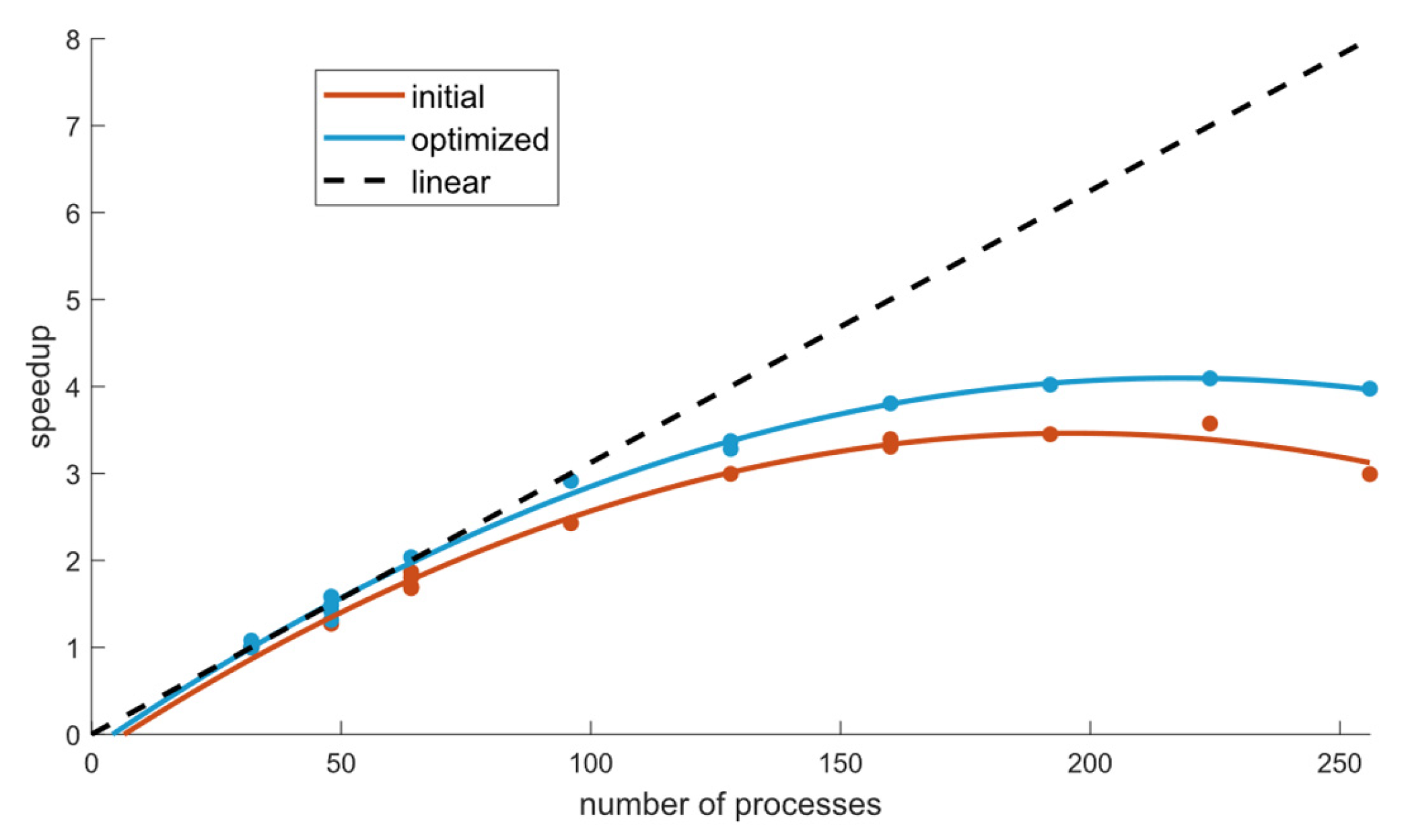1. Introduction
Weather forecasting is closely linked to our production activities and daily life. Against the backdrop of global warming, extreme weather and climate events are occurring with increasing frequency [
1]. For instance, China has experienced a significant rise in extreme heavy rainfall and large-scale extreme heat events in recent years, characterized by extended durations and more frequent record-breaking occurrences [
2]. Research by AghaKouchak et al. highlights that extreme weather events globally are exhibiting characteristics that diverge from historical patterns [
3]. Consequently, timely and accurate weather forecasting is essential for protecting lives and property.
Despite the growing influence of machine learning in weather forecasting, numerical models remain the primary tool for weather prediction. Depending on the spatial discretization schemes employed, numerical models can be divided into two categories: grid-point models and spectral models. While spectral models involve more complex forecasting processes, they offer more stable integrations and more accurate results. These advantages make spectral models widely used in operational forecasting systems [
4]. The Yin-He Global Spectral Model (YHGSM) developed by the National University of Defense Technology is a spectral model.
YHGSM is designed for high-resolution forecasting and climate research. It features advanced parallel computing techniques to greatly improve computational efficiency and scalability. By integrating the finite volume method (FVM), YHGSM reduces spectral transform costs while maintaining forecast accuracy. It effectively simulates extreme weather events and supports model coupling, extending its applications to atmosphere–ocean interactions and climate trend analysis [
5]. With good performance in both accuracy and efficiency, YHGSM plays a vital role in modern weather and climate modeling.
Spectral models rely on parallel computing technologies to meet the stringent real-time demands of weather forecasting. Improving the efficiency of these models on multi-node systems has long been a key area of research. As hardware scales continue to grow, the proportion of communication overhead has also increased. In the realm of parallel optimization, the technique of overlapping communication with computation has gained prominence. Effective strategies for hiding communication overhead can lead to substantial performance gains, making it a critical focus for optimizing the performance of spectral models [
6,
7,
8,
9,
10].
MPI (Message Passing Interface) is the mainstream communication interface used in parallel programming, supported by most multi-node systems and networks. The MPI Forum introduced non-blocking communication mechanisms in the MPI-2 standard [
11] and non-blocking collective communication in the MPI-3 standard [
12]. These features facilitate the overlapping of computation with communication [
13]. However, the effectiveness of such overlapping, from a performance perspective, depends on the specific implementation and the underlying system architecture. Non-blocking operations enable the possibility of overlapping communication with computation, but do not guarantee it [
14].
For YHGSM, based on restructuring interpolation arrays and overlapping communication with computation across subarrays, the efficiency of the semi-Lagrange interpolation has been significantly enhanced recently [
15]. However, the method does not consider how to progress non-blocking operations, leaving it to the parallel computer, and it has not been extended to other parts of the model. In fact, the spectral transform involves a significant volume of communication as well. Therefore, if we can effectively hide this communication overhead within computation time, the runtime of the model can be significantly reduced further, boosting the operational efficiency of YHGSM.
In this paper, we analyze the spectral transform of YHGSM, with a particular focus on the Fourier transform section. This section involves significant communication overhead due to the three-dimensional data transposition. By grouping and interleaving communication and computation and leveraging MPI’s asynchronous communication, the communication overhead is significantly reduced. Experiments conducted on a multi-node cluster demonstrate that the runtime of this section is reduced by about 30%, highlighting the effectiveness of the proposed method.
The remainder of this paper is organized as follows:
Section 2 provides background information on YHGSM and MPI non-blocking communication.
Section 3 details the implementation of the strategy for overlapping communication with computation.
Section 4 outlines the experimental results. Finally,
Section 5 summarizes the work and draws conclusions.
2. Background
2.1. Three-Dimensional Data Transposition in YHGSM
YHGSM is a global, medium-range numerical weather prediction system developed by the National University of Defense Technology. This model employs spectral modeling technology, integrating advanced dynamic frameworks and physical processes to enhance the accuracy and reliability of weather forecasts. Additionally, it incorporates four-dimensional variational assimilation (4D-VAR) techniques to improve the initial conditions and, consequently, the forecast quality [
16].
In YHGSM, forecast variables are transformed from grid data to spectral coefficients, and the forecast state is advanced in spectral space. This process involves data transpositions between grid space, Fourier space, and spectral space, as shown in
Figure 1. This procedure is carried out across four main stages.
The first stage is the Initial Grid Partitioning. During the grid-space computations, data are partitioned along the horizontal dimensions. In the μ (zonal) direction, data are divided into multiple A sets. For instance, processes P1 and P2 belong to the same A1 set. In the λ (meridional) direction, data are divided into multiple B sets. For example, P1 and P3 belong to the same B1 set.
The second stage is the First Data Transposition. Before the Fourier transform, a 3D transposition is needed to rearrange the data layout. This transposition enables data alignment along the vertical (z) and zonal (μ) directions and involves intra-A set communication. After this step, the data are restructured into V sets and W sets.
The third is the Fourier transform. The Fourier transform maps the λ dimension to the m dimension.
The last is the Second Data Transposition. Prior to the Legendre transform, a second transposition is performed to prepare the data for spectral-space operations. This step involves communication within each V set, reorganizing data into W sets across the m dimension. To achieve load balancing, m values are distributed cyclically across the W sets. For instance, in
Figure 1, m0 and m2 may be assigned to W1, while m1, m3, and m4 are handled by W2.
Throughout the above procedure, each data transposition involves significant communication overhead. If this communication overhead can be hidden within the preceding and subsequent computation stages, the program’s execution efficiency can be improved.
2.2. MPI Non-Blocking Communication
MPI is a parallel computing programming model and library standard that defines a set of specifications and functions for enabling communication and parallel computation on distributed memory systems. MPI is widely used in large-scale scientific and engineering computational applications [
17,
18].
The MPI programming model is based on a message-passing mechanism, and programmers need to explicitly define parallel tasks, message-passing operations, and synchronization between processes [
19]. MPI supports two fundamental modes of communication: point-to-point communication and collective communication.
To prevent deadlock issues and facilitate the overlapping of communication with computation, the MPI Forum introduced non-blocking communication functions. Non-blocking communication essentially splits blocking communication into two parts: initiation and completion. Once a non-blocking communication call is made, control is returned immediately to the process, allowing it to continue with computation tasks. Only when it is necessary to ensure that the communication has completed, the MPI_WAIT function is called to finalize the communication [
20]. Although non-blocking communication calls return immediately, the MPI standard does not guarantee that communication will occur concurrently with computation. Therefore, in practical implementations, simply using non-blocking communication may fail to achieve effective computation–communication overlapping [
21]. As illustrated in
Figure 2, communication may not actually begin until the MPI_WAIT function is invoked.
To ensure the quality of communication, the MPI standard employs two different protocols for handling small and large messages: the eager protocol for small messages and the rendezvous protocol for large messages. The MPI standard also uses a communication progress model to ensure the completion of communication operations. When a process initiates a communication, it must actively manage the progress of the communication to ensure its eventual completion [
22,
23]. Overlapping communication with computation is particularly important when using the rendezvous protocol to transfer large messages. However, the rendezvous protocol involves multiple interactions between the sender and receiver, requiring more active management of communication progress. At certain points, advancing communication progress necessitates invoking specific functions, such as MPI_WAIT and MPI_TEST [
24]. In the case of blocking communication, this is equivalent to calling MPI_WAIT immediately after starting the communication, continuously polling for progress until it is complete. For non-blocking communication, achieving communication progress becomes an implementation-dependent issue, which is crucial for effectively overlapping communication with computation.
To achieve communication progress and overlap it with computation in non-blocking situations, three common approaches are typically employed.
The first method involves significantly modifying the program. As illustrated in
Figure 3, it requires inserting multiple calls to the MPI_TEST function at regular intervals within the computation segment intended to overlap with communication. According to the MPI standard, MPI_TEST not only checks if a specified communication operation has completed but also advances the communication to the next stage if it detects that progress is needed. However, a major drawback of this approach is that the placement and frequency of MPI_TEST calls are entirely controlled by the programmer [
25]. Since communication progress is opaque to programmers, they must rely on trial and error to determine the optimal timing for these calls. Furthermore, in practical applications, computational segments often depend on scientific computing libraries, making it challenging to insert MPI_TEST calls appropriately and achieve effective computation–communication overlap.
The second method, offloading MPI communication entirely to dedicated hardware, is the optimal solution. This approach requires no additional effort from the programmer to manage progress and avoids wasting hardware resources [
26,
27]. However, it requires the system to be designed with this capability in mind, making it highly dependent on effective software–hardware coordination. Due to the need for specialized system implementations, which are not yet widely available, this method is rarely used in practice to achieve efficient overlap between computation and communication.
The third method, using asynchronous progress threads, offers a practical and balanced approach to overlapping communication with computation. This extension is widely supported in general-purpose MPI implementations and requires minimal code changes, making it suitable for most systems. For instance, in MPICH v3.2, setting the environment variable MPICH_ASYNC_PROGRESS = 1 enables this feature. MPI then automatically creates a dedicated communication thread for each process. The main thread continues with computation after initiating communication, and the progress thread handles communication advancement in the background.
However, CPU core contention must be considered. If both threads share a core (see
Figure 4), performance may suffer due to competition for CPU cycles. To avoid this, it is recommended to assign a dedicated core to the progress thread whenever resources are available [
28].
2.3. Recent Advances in Parallel Optimization for YHGSM
In recent years, with the rapid advancement of HPC, numerical models such as YHGSM have undergone continuous parallel optimization to meet the increasing demands of high-resolution global numerical weather prediction [
29,
30,
31]. By addressing various parallel bottlenecks, multiple advanced parallel strategies have been introduced and refined, significantly improving the model’s computational efficiency and scalability.
Extensive efforts have been made to improve the parallel performance of the YHGSM model. To optimize the semi-Lagrangian scheme in YHGSM, one-sided communication was introduced to enhance the efficiency of the model. Tests show that the number of communication operations was reduced by approximately 50%, significantly improving parallel efficiency while preserving interpolation accuracy [
32].
Another work in optimizing YHGSM’s parallel performance was undertaken in 2021, when researchers introduced a variable-based subarray grouping strategy for the semi-Lagrangian interpolation scheme [
15]. Instead of processing all prognostic variables together, the fields were partitioned into independent subarrays—each interpolated and communicated separately.
Building on this, Liu et al. proposed a further refinement through a communication–computation overlapping strategy with grouping of vertical levels. Recognizing that the 93 vertical layers in YHGSM exhibit weak inter-layer dependencies, the scheme divides these layers into three groups [
16]. Each group performs non-blocking communication and interpolation in a staggered manner, allowing the communication of one group to overlap with the computation of another. This approach effectively reduces the idle time during the semi-Lagrangian interpolation and achieved a 12.5% reduction in runtime on a 256-core system.
While YHGSM has achieved considerable progress in parallel optimization—particularly in semi-Lagrangian schemes—certain components of the model, such as the spectral transform, remain communication-intensive. Among these, the Fourier transform stage poses a significant performance bottleneck due to the large volume of data transposition across three dimensions. If this communication overhead can be effectively hidden within computation through careful program restructuring and system-level tuning, the runtime of the model can be further reduced.
4. Experiment
The numerical experiments presented in this paper were conducted on a cluster with 85 nodes, each equipped with two 18-core Intel(R) Xeon(R) Gold 6150 CPUs (Intel Corporation, Santa Clara, CA, USA) running at 2.7 GHz and 192 GB of RAM (cores were allocated on demand according to each experimental configuration, rather than fully occupying all available cores in every run). The nodes are interconnected via a high-speed InfiniBand network. The operating system used was Linux 3.10.0–862.9.1 (available at
https://www.kernel.org/), and the compiler was Intel 19.0.0.117 (Intel Corporation, Santa Clara, CA, USA). MPICH 3.3.2 was employed for inter-process communication. To implement the overlap of communication with computation based on MPI non-blocking operations, we set the environment variable MPICH_ASYNC_PROGRESS = 1 and allocated two cores for each MPI process. Comparative experiments between the optimized and initial schemes were performed using the YHGSM TL1279 version with an integration time of 600 s. A two-dimensional parallelization scheme was adopted, with the total number of processes determined by the product of the process counts in the W and V directions. Each runtime measurement was averaged over five trials. Since the three-dimensional data transposition involves coordination among processes within the same V-set communication domain, the MPI_BARRIER function was used to synchronize the processes within this domain before entering the Fourier transform section, ensuring the accuracy of wall-clock time measurements.
To measure the runtime of the Fourier transform section, the number of V and W sets was varied. Communication and computation were divided into three groups, and the YHGSM was run for six steps. The performance of three implementations—blocking collective communication, non-blocking point-to-point communication, and non-blocking collective communication—was compared.
Figure 9a illustrates the time distribution between the computation and communication phases within the Fourier transform component of the YHGSM model. As shown in the figure, communication overhead constitutes a substantial portion of the total runtime across most configurations. Notably, in the 8 × 16 case, communication accounts for as much as 58.5% of the total execution time. This highlights communication as a major performance bottleneck. To address this challenge, dedicated communication optimizations are essential. As shown in
Figure 9b, the Fourier transform stage accounts for approximately 5% of the total model runtime. Although this proportion may appear small, it should be noted that the wall-clock time of YHGSM run includes multiple components such as I/O, physics parameterizations, and other computations. In this context, a 5% share is non-negligible. Moreover, optimizations in this stage yield performance benefits in every single time step of the model integration and can be readily generalized to other spectral models.
Figure 10a illustrates how computation times change with varying V × W configurations across the three implementations. In the latter two implementations, which use non-blocking communication, communication and computation can overlap. It can be observed that as the total number of processes increases, the overall computation time for the Fourier transform decreases. This trend is primarily due to the fact that a higher number of processes reduces the workload per process. Additionally, regardless of whether communication is overlapped or computation is grouped, the measured computation time remains relatively unchanged, as the total computation workload per MPI process remains fixed once the values of V and W are determined.
Figure 10b shows how communication times change with varying V × W configurations across the three implementations. For the blocking case, the data represent the actual communication overhead, whereas in the non-blocking cases, the measurement includes the overhead of both the MPI non-blocking communication initiation and completion functions across all communication groups. The results indicate that using asynchronous progress threads to overlap communication with computation is clearly effective, leading to a significant reduction in communication overhead.
It is important to note that the MPI non-blocking communication initiation and completion functions themselves introduce some overhead. Therefore, non-blocking communication yields performance benefits only when the original communication cost is greater than this overhead. The extent of the benefits also depends on the ratio of computation to communication overhead, as well as the efficiency of hardware–software coordination on the execution platform.
As the number of processes increases, there is a general trend of decreasing communication time in
Figure 10b. This is influenced by two factors: first, the increase in the number of communication operations results in greater invocation overhead; second, each communication operation involves less data. However, the total communication overhead is dominated by the latter, thereby it is reduced step by step. Additionally, it can be observed that for most V × W configurations, the point-to-point non-blocking operation incurs less overhead compared to the collective version. This may be due to the relatively small total number of processes, which limits the ability of collective operations to fully leverage their advantages.
Figure 11 presents the total runtime of the Fourier transform section before and after optimization, with YHGSM running 6 steps, each with a time step of 600 s. The results demonstrate that the computation–communication overlap strategy significantly reduces runtime in this section. This improvement is attributed to the use of pipelining, which effectively hides part of the communication overhead. Notably, the optimization yields the greatest benefit at 128 processes, achieving up to a 30% reduction in execution time. Moreover, the overall runtime shows a decreasing trend as the number of processes increases, demonstrating a certain level of scalability.
To assess the performance impact of the proposed optimization, we measured the runtime components in both the original and optimized implementations. In the baseline version, communication during the Fourier transform stage accounted for approximately 30% to 60% of the total execution time, revealing a communication bottleneck that constrained both scalability and overall performance.
To quantify the benefit of the overlap strategy, we introduce the Communication Hiding Ratio (CHR), defined in Equation (1). Here,
refers to the total communication time in the blocking implementation without any overlap, and
denotes the portion of communication time that is not overlapped by computation. A CHR value close to 1 indicates that most of the communication time has been successfully hidden behind computation:
Figure 12 shows that the CHR varies between 40% and 75% across different configurations, demonstrating that a significant portion of the communication latency has been successfully overlapped with computation.
Figure 13a,b show the speedup and parallel efficiency of the Fourier transform section before and after optimization. It can be observed that across various V × W configurations, both speedup and parallel efficiency have improved, further demonstrating the effectiveness of the optimization strategy. The baseline uses 32 MPI processes without computation–communication overlap, each mapped to a physical core (the model cannot run correctly with a single process). We do not count the asynchronous progress threads as additional computational resources because they are active only during the computation–communication overlap phases and do not contribute to other parts of the execution.
Figure 14 illustrates the speedup of the Fourier transform section before and after applying the computation–communication overlap optimization, using the 32-process configuration as the baseline. The results demonstrate a clear improvement in speedup after optimization, with the curve approaching ideal linear behavior more closely than the unoptimized version. This confirms the effectiveness of the proposed overlap strategy in this communication-intensive section. This experiment focuses on the Fourier transform stage of the model, which is inherently constrained in scalability due to its intensive all-to-all communication. By applying the optimization, we achieved a clear performance improvement. Extending this strategy to other similarly constrained components is expected to enhance the overall scalability of the model.
5. Conclusions
In YHGSM, frequent transformations between grid space and spectral space are required, particularly three-dimensional data transpositions between Fourier transforms and Legendre transforms. These operations involve significant communication overhead across multiple processes. To address this issue and improve runtime efficiency, we analyzed the data dependencies and program structure between the Fourier transform computations and communication tasks. Based on this analysis, we proposed a method that achieves partial overlap of communication and computation by grouping them along the field dimension and executing in a pipelined manner.
In our implementation, we adopted MPI non-blocking communication and leveraged asynchronous progress threads supported by MPICH to enable effective overlap. Experimental results demonstrated that the optimized scheme, which groups operations by field dimension, successfully reduced the runtime of the Fourier transform section in YHGSM. Compared to the original scheme, we observed improvements in speedup and parallel efficiency. Specifically, with a process configuration of V × W = 8 × 16, the optimized scheme reduced runtime by up to 30%. These results confirm the effectiveness of our computation–communication overlap strategy in YHGSM and suggest potential applications for other parts of YHGSM with significant communication costs or even for other spectral models.
Looking forward, the proposed approach shows strong potential for generalization. It could be extended to other components of YHGSM where communication costs dominate, such as Legendre transforms or semi-Lagrangian interpolation stages. Furthermore, the grouping and pipelining strategy can be applied to other spectral models that face similar computational and communication bottlenecks. More broadly, this method contributes to ongoing efforts in high-performance computing to optimize tightly coupled parallel applications and may inspire future research on automated task reorganization, hybrid communication strategies, and adaptive overlap mechanisms in large-scale scientific simulations.
That said, generalizing the proposed method to other modules may present additional challenges due to differences in data dependencies, communication patterns, and memory access behaviors. These factors could affect the feasibility and effectiveness of pipelined execution and will be important considerations in our future work.
